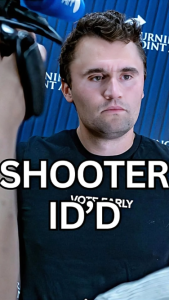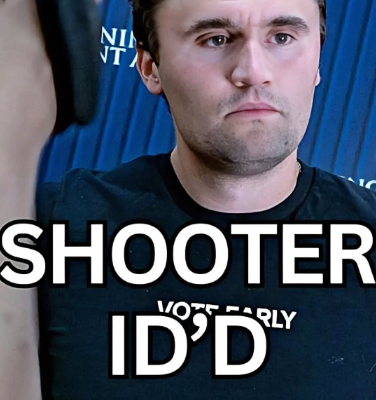🕵️ The Image That Shook a Nation
On September 12, 2025, the FBI released surveillance photos of a person of interest in the assassination of Charlie Kirk—a man whose voice had become synonymous with conservative activism, campus debate, and political provocation. The images, pulled from stairwell cameras at Utah Valley University, show a figure ascending toward a rooftop. Minutes later, a single shot rang out. Kirk, 31, was struck in the neck while speaking to a crowd of 3,000 students.
The photo is grainy. The man wears a baseball cap, sunglasses, and a shirt printed with an American flag. He’s not running. He’s not hiding. He’s climbing. Purposefully. Quietly. And that quiet is what makes the image so chilling.
🎭 The Face of Ambiguity
We don’t know his name. We don’t know his motive. We don’t even know if he pulled the trigger. But we know he was there. Before the event began. Before the crowd gathered. Before the bullet shattered a moment of speech into a lifetime of silence.
This is the power of surveillance: it captures presence, not intent. It freezes motion, not meaning. And in that ambiguity, we project. We speculate. We grieve.
🧠 The Psychology of the “Person of Interest”
The term itself—“person of interest”—is designed to be vague. It doesn’t accuse. It doesn’t absolve. It simply marks someone as relevant. And in this case, relevance is heavy.
The man in the photo is now part of a national narrative. His image has been shared across platforms, dissected by analysts, and burned into the minds of those who watched Kirk’s final moments unfold. He is not just a suspect. He is a symbol. Of unanswered questions. Of public vulnerability. Of the thin line between speech and silence.
🫂 The Family: Grieving in the Shadow of a Manhunt
While the FBI urges the public to send tips, Kirk’s family is left to mourn. His wife, Erika, collapsed at the scene. His two young daughters lost their father. And his parents—elderly, stunned—watched their son become a headline.
The photo of the person of interest doesn’t just represent a lead in the investigation. It represents the last thread of hope for closure. For accountability. For justice.
And yet, it also deepens the wound. Because every time it’s shared, it reminds the family of what was taken.
🔍 The Investigation: A Trail of Clues and Silence
Authorities recovered a high-powered bolt-action rifle in a wooded area near the university. Ammunition reportedly bore ideological inscriptions, though officials have not confirmed their authenticity. Two individuals were taken into custody and later released, cleared of suspicion.
The man in the photo remains unidentified. The FBI has offered a $100,000 reward for information leading to his arrest. They’ve asked the public to examine the images, to search their memories, to come forward.
And in doing so, they’ve turned a private tragedy into a communal mission.
📸 The Visual Language of Justice
Photos like these carry weight. They’re not just evidence. They’re emotional triggers. They invite empathy, fear, anger, and speculation. They become part of the public consciousness.
This particular image—of a man climbing toward a rooftop—has already inspired countless interpretations. Some see a lone wolf. Others see a pawn. Some see a monster. Others see a mystery.
But all see a moment frozen in time. A moment that preceded a national rupture.
🧩 Possible Titles for the Image
Let’s reframe the photo through poetic lenses:
- “The Climb Before the Collapse”
- “Stairwell to Silence”
- “The Man Who Was There”
- “Shadow in the Spotlight”
- “Unmasked by Memory”
Each title invites a different emotional entry point. Each one honors the ambiguity. Each one asks us to look deeper.
🌐 The National Response: Shock, Unity, and Division
President Donald Trump called the killing a “political assassination” and vowed that the killer would be “dealt with very appropriately”. Flags were ordered to fly at half-mast until September 14. Vigils were held. Tributes poured in. And debates reignited—about security, speech, and the cost of public discourse.
This is the paradox of tragedy: it unites and divides. It brings people together in grief, and pushes them apart in ideology.
And the photo? It sits at the center of that paradox.
🧠 The Ethics of Exposure
Should we share the image? Should we speculate? Should we turn a man into a meme before he’s named?
These are the questions that haunt modern justice. Because visibility is power. And power, when misused, becomes persecution.
The FBI has asked for help. But they’ve also asked for patience. For restraint. For respect.
Because the man in the photo is not just a clue. He’s a person. And until the truth is known, he remains a question.
✨ Final Reflection: The Stairwell and the Silence
The photo released by the FBI is more than surveillance. It’s a symbol. Of a moment before impact. Of a nation holding its breath. Of a family waiting for answers.
It reminds us that justice is not just about punishment. It’s about understanding. About truth. About healing.
And it calls us to reflect—not just on who the man is, but on what his presence means. On how we respond to violence. On how we protect speech. On how we honor grief.
So yes, the photo is out. And the search continues. But in the meantime, we look. We feel. We remember.
Because behind every image is a story. And behind every story is a heartbeat.


